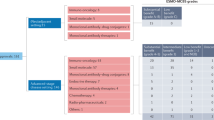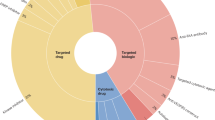Abstract
Between January 2001 and January 2012, 48 new medicinal products for cancer treatment were licensed within the EU, and 77 new indications were granted for products already licensed. In some cases, a major improvement to existing therapies was achieved, for example, trastuzumab in breast cancer. In other cases, new fields for effective drug therapy opened up, such as in chronic myeloid leukemia, and renal-cell carcinoma. In most cases, however, the benefit–risk balance was considered to be only borderline favorable. Based on our assessment of advice procedures for marketing authorization, 'need for speed' seems to be the guiding principle in anticancer drug development. Although, for drugs that make a difference, early licensure is of obvious importance to patients, this is less evident in the case of borderline drugs. Without proper incentives and with hurdles inside and outside companies, a change in drug development cannot be expected; drugs improving benefit–risk modestly over available therapies will be brought forward towards licensure. In this Perspectives article, we discuss some hurdles to biomarker-driven drug development and provide some suggestions to overcome them.
This is a preview of subscription content, access via your institution
Access options
Subscribe to this journal
Receive 12 print issues and online access
$209.00 per year
only $17.42 per issue
Buy this article
- Purchase on Springer Link
- Instant access to full article PDF
Prices may be subject to local taxes which are calculated during checkout

Similar content being viewed by others
References
Arteaga, C. L. et al. Treatment of HER2-positive breast cancer: current status and future perspectives. Nat. Rev. Clin. Oncol. 9, 16–32 (2012).
Quintás-Cardama, A., Kantarjian, H. & Cortes, J. Imatinib and beyond—exploring the full potential of targeted therapy for CML. Nat. Rev. Clin. Oncol. 6, 535–543 (2009).
Sleijfer, S., Wiemer, E. & Verweij, J. Drug Insight: gastrointestinal stromal tumors (GIST)—the solid tumor model for cancer-specific treatment. Nat. Clin. Pract. Oncol. 5, 102–111 (2008).
Ravaud, A. et al. Update on the medical treatment of metastatic renal cell carcinoma. Eur. Urol. 54, 315–325 (2008).
Apolone, G., Tafuri, G., Trotta, F. & Garattini S. A new anti-cancer drug in the market: Good news for investors or for patients? Eur. J. Cancer 44, 1786–1788 (2008).
Ocana, A. & Tannock, I. F. When are “positive” clinical trials in oncology truly positive? J. Natl Cancer Inst. 103, 16–20 (2011).
Roberts, T. G. Jr, Lynch, T. J. Jr & Chabner, B. A. The phase III trial in the era of targeted therapy: unraveling the “go or no go” decision. J. Clin. Oncol. 21, 683–695 (2003).
Hanahan, D. & Weinberg, R. A. Hallmarks of cancer: the next generation. Cell 144, 646–674 (2011).
Bergh, J. Quo vadis with targeted drugs in the 21st century? J. Clin. Oncol. 27, 2–5 (2009).
Amir, E. et al. Oncogenic targets, magnitude of benefit, and market pricing of antineoplastic drugs. J. Clin. Oncol. 29, 2543–2549 (2011).
Europa. Regulation (EC) No 726/2004 of the European Parliament and of the Council of 31 March 2004 Laying down community procedures for the authorisation and supervision of medicinal products for human and veterinary use and establishing a European Medicines Agency [online], (2004).
Pignatti, F. et al. The European Medicines Agency: an overview of its mission, responsibilities, and recent initiatives in cancer drug regulation. Clin. Cancer Res. 17, 220–225 (2011).
European Medicines Agency. Scientific guidelines [online], (2012).
Committee for Medicinal Products for Human Use. Guideline on the evaluation of anticancer medicinal products in man [online], (2005).
Committee for Medicinal Products for Human Use. Guideline on the evaluation of anticancer medicinal products in man—draft [online], (2011).
Europa. Directive 2001/83/EC of the European Parliament and of the Council of 6 November 2001 on the Community code relating to medicinal products for human use [online], (2001).
European Medicines Agency. EPAR summary for the public. Tyverb[online], (2010).
Van Cutsem, E. et al. Open-label phase III trial of panitumumab plus best supportive care compared with best supportive care alone in patients with chemotherapy-refractory metastatic colorectal cancer. J. Clin. Oncol. 25, 1658–1664 (2007).
Committee for Medicinal Products for Human Use. European Public Assessment report (EPAR) for Vectibix, Scientific discussion [online], (2007).
Amado, R. G. et al. Wild-type KRAS is required for panitumumab efficacy in patients with metastatic colorectal cancer. J. Clin. Oncol. 26, 1626–1634 (2008).
Benvenuti, S. et al. Oncogenic activation of the RAS/RAF signaling pathway impairs the response of metastatic colorectal cancers to anti-epidermal growth factor receptor antibody therapies. Cancer Res. 67, 2643–2648 (2007).
Lièvre, A. et al. KRAS mutation status is predictive of response to cetuximab therapy in colorectal cancer. Cancer Res. 66, 3992–3995 (2006).
Mok, T. S. et al. Gefitinib or carboplatin-paclitaxel in pulmonary adenocarcinoma. N. Engl. J. Med. 361, 947–957 (2009).
Thatcher, N. et al. Gefitinib plus best supportive care in previously treated patients with refractory advanced non-small-cell lung cancer: results from a randomised, placebo-controlled, multicentre study (Iressa Survival Evaluation in Lung Cancer). Lancet 366, 1527–1537 (2005).
Kim, E. S. et al. Gefitinib versus docetaxel in previously treated non-small-cell lung cancer (INTEREST): a randomised phase III trial. Lancet 372, 1809–1818 (2008).
Goss, G. et al. Randomized phase II study of gefitinib compared with placebo in chemotherapy-naive patients with advanced non-small-cell lung cancer and poor performance status. J. Clin. Oncol. 27, 2253–2260 (2009).
Maruyama, R. et al. Phase III study, V-15-32, of gefitinib versus docetaxel in previously treated Japanese patients with non-small-cell lung cancer. J. Clin. Oncol. 26, 4244–4252 (2008).
Committee for Medicinal Products for Human Use. Assessment report for Iressa [online], (2009).
Simon, R. M., Paik, S. & Hayes, D. F. Use of archived specimens in evaluation of prognostic and predictive biomarkers. J. Natl Cancer Inst. 101, 1446–1452 (2009).
European Medicines Agency. Scientific Advice Working Party [online], (2012).
Druker, B. J. & Lydon, N. B. Lessons learned from the development of an abl tyrosine kinase inhibitor for chronic myelogenous leukemia. J. Clin. Invest. 105, 3–7 (2000).
Joensuu, H. et al. Effect of the tyrosine kinase inhibitor STI571 in a patient with a metastatic gastrointestinal stromal tumor. N. Engl. J. Med. 344, 1052–1056 (2001).
Reichert, J. M. & Valge-Archer, V. A. Development trends for monoclonal antibody cancer therapeutics. Nat. Rev. Drug Discov. 6, 349–356 (2007).
Jubb, A. M. & Harris, A. L. Biomarkers to predict the clinical efficacy of bevacizumab in cancer. Lancet Oncol. 11, 1172–1183 (2010).
Martini, M., Vecchione, L., Siena, S., Tejpar, S. & Bardelli, A. Targeted therapies: how personal should we go? Nat. Rev. Clin. Oncol. 9, 87–97 (2012).
Gao, B., Klumpen, H. J. & Gurney, H. Dose calculation of anticancer drugs. Expert Opin. Drug Metab. Toxicol. 4, 1307–1319 (2008).
Jacobs, A. D. et al. A randomized phase III study of rubitecan (ORA) vs. best choice (BC) in 409 patients with refractory pancreatic cancer report from a North-American multi-center study [abstract]. J. Clin. Oncol. 22 (14 Suppl.), a4013 (2004).
Moore, M. J. et al. Erlotinib plus gemcitabine compared with gemcitabine alone in patients with advanced pancreatic cancer: a phase III trial of the National Cancer Institute of Canada Clinical Trials Group. J. Clin. Oncol. 25, 1960–1966 (2007).
Committee for Medicinal Products for Human Use. European Public Assessment report (EPAR) for Tarceva-H-C-618-II-02 Variation, Scientific discussion [online], (2007).
Lachin, J. L. Statistical considerations in the intent-to-treat principle. Control Clin. Trials 21, 167–189 (2000).
Van Cutsem, E. et al. Cetuximab dose-escalation study in patients with metastatic colorectal cancer (mCRC) with no or slight skin reactions on cetuximab standard dose treatment (EVEREST): Pharmacokinetic and efficacy data of a randomized study [abstract]. ASCO Gastrointestinal Cancers Symp. a237 (2007).
Chapman, P. B. et al. Improved survival with vemurafenib in melanoma with BRAF V600E mutation. N. Engl. J. Med. 364, 2507–2516 (2011).
Committee for Medicinal Products for Human Use. Reflection paper on methodological issues in confirmatory clinical trials planned with an adaptive design [online], (2007).
Gerlinger, M. & Swanton, C. How Darwinian models inform therapeutic failure initiated by clonal heterogeneity in cancer medicine. Br. J. Cancer. 103, 1139–1143 (2010).
Floriani, I., Garattini, S. & Torri, V. Looking for efficiency rather than efficacy in randomized controlled trials in oncology. Ann. Oncol. 21, 1391–1393 (2010).
Frank, N. Y., Schatton, T. & Frank, M. H. The therapeutic promise of the cancer stem cell concept J. Clin. Invest. 120, 41–50 (2010).
Hait, W. N. Anticancer drug development: the grand challenges. Nat. Rev. Drug Discov. 9, 253–254 (2010).
Simmons, C. et al. Does confirmatory tumor biopsy alter the management of breast cancer patients with distant metastases? Ann. Oncol. 20, 1499–1504 (2009).
Lindström, L. et al. in ASCO Educational Book 2010 Breast Cancer 7–12 (ASCO, 2010).
Thompson, A. M. et al. Prospective comparison of switches in biomarker status between primary and recurrent breast cancer: the Breast Recurrence In Tissues Study (BRITS). Breast Cancer Res. 12, R92 (2010).
Morgan, S., Grootendorst, P., Lexchin, J., Cunningham, C. & Greyson, D. The cost of drug development: a systematic review. Health Policy 100, 4–17 (2011).
Light, D. W. & Warburton, R. Demythologizing the high costs of pharmaceutical research. BioSocieties 6, 34–50 (2011).
Walker, I. & Newell, H. Do molecularly targeted agents in oncology have reduced attrition rates? Nat. Rev. Drug Discov. 8, 15–16 (2009).
Official Journal of the European Communities. Commission Regulation (EC) No 847/2000 of 27 April 2000. Laying down the provisions for implementation of the criteria for designation of a medicinal product as an orphan medicinal product and definitions of the concepts 'similar medicinal product' and'clinical superiority' [online], (2000).
Acknowledgements
The authors would like to acknowledge Francesco Pignatti of the European Medicines Agency, Oncology Sector and Jorge Martinalbo of the European Medicines Agency, Scientific Advice Sector for constructive discussions and expert search of databases. The views expressed in this article are the personal views of the authors and may not be understood or quoted as being made on behalf of or reflecting the position of the European Medicines Agency or one of its committees or working parties.
Author information
Authors and Affiliations
Contributions
Both authors made a substantial contribution to researching data for the article, discussion of content, and to writing and editing the manuscript before submission.
Corresponding author
Ethics declarations
Competing interests
The authors declare no competing financial interests.
Rights and permissions
About this article
Cite this article
Jonsson, B., Bergh, J. Hurdles in anticancer drug development from a regulatory perspective. Nat Rev Clin Oncol 9, 236–243 (2012). https://doi.org/10.1038/nrclinonc.2012.14
Published:
Issue Date:
DOI: https://doi.org/10.1038/nrclinonc.2012.14
This article is cited by
-
Evidence supporting regulatory-decision making on orphan medicinal products authorisation in Europe: methodological uncertainties
Orphanet Journal of Rare Diseases (2018)
-
Effect of Tyrosine Kinase Inhibitors on Wound Healing and Tissue Repair: Implications for Surgery in Cancer Patients
Drug Safety (2014)
-
Oncology trials—the elephant in the room
Nature Reviews Clinical Oncology (2012)



